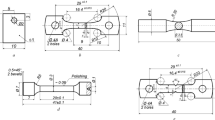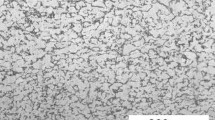Conclusions
-
1.
Prolonged heating (30, 000 h) of α titanium alloys in air at 200–400° leads to negligible contamination of the surface layer with oxygen.
-
2.
The oxide film formed on titanium under operating conditions probably has an unfavorable effect on the working capacity of titanium, which should be taken into account in designing structures intended for prolonged operation at elevated temperatures in air.
Similar content being viewed by others
Literature cited
E. N. Novikova, L. P. Luzhnikov, and V. F. Kononova, Titanium — A New Structural Material [in Russian], Nauka, Moscow (1972), pp. 137–142.
V. V. Latsh and L. F. Sokiryanskii, Tekhnologiya Legkikh Splavov, 5, 83 (1969).
B. V. Mott, Microhardness Tests [Russian translation], Metallurgizdat, Moscow (1960).
I. Kramer and L. Delyar, Effect of Environment on Mechanical Properties of Metals [in Russian], Metallurgiya, Moscow (1964).
V. P. Alekhin et al., Fiz. i Khim. Obrabotki Mat., 6, 60 (1971).
Additional information
All-Union Scientific-Research Institute of Aviation Materials. Translated from Metallovedenie i Termicheskaya Obrabotka Metallov, No. 4, pp. 33–36, April, 1974.
Rights and permissions
About this article
Cite this article
Luzhnikov, L.P., Novikova, E.A. & Sokiryanskii, L.F. Saturation of titanium alloys with gases at 200–400° C. Met Sci Heat Treat 16, 316–318 (1974). https://doi.org/10.1007/BF00679225
Issue Date:
DOI: https://doi.org/10.1007/BF00679225




